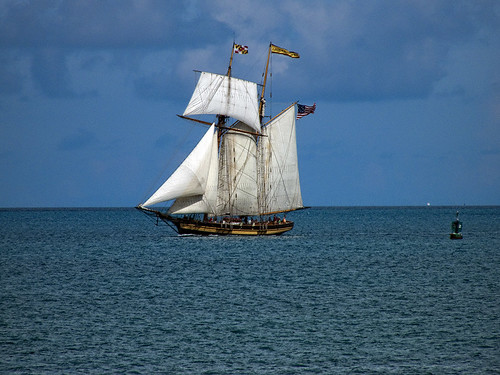For the book Tall Ship Odysseys, which commemorates a handful of the people and the gatherings of Operation Sail across five decades, I spoke with Jan Miles, captain of the Pride of Baltimore II. This post finds the Pride II on a summer voyage of the Great Lakes. In September the 200th anniversary of the Battle of Lake Erie and Oliver Hazard Perry's victory will be celebrated with eight ships at Put-in-Bay, Ohio.
Aboard a Baltimore clipper
Jan Miles started as an interim captain with the Pride I in 1981, having worked as a mate on large sailing vessels for nine years. He had a fascination with Baltimore clippers and their origins in the China trade of the 1700s and early 1800s. In those days, the ships that set out from Philadelphia, Boston and New York heading for Asia were paradoxically smaller than those in the Europe trade. Going to Asia, ships couldn't rely on protection from a flag. The American response to the risks was to use small, high-value cargo (starting with ginseng) and focus on speed and agility.
In 1986 tragedy struck the Pride I and in the years after it sank, its successor started a Christa McCullough fellowship, honoring the teacher who died in the tragedy. That's how Miles would later meet his wife, a teacher who held the fellowship in 1998.
In 1992 when an international gathering of ships was planned for Puerto Rico, there was lots of discussion about whether to participate. Ultimately, the Pride II set sail that summer for Puerto Rico via Bermuda to join the transatlantic fleet coming from Las Palmas.
Miles had a few misgivings. "This was the first big fleet since 1986," he said. "There was passion involved. Puerto Rico has a particular draw" for northern sailors. "There was a sense of anticipation."
As they neared the island, the crew’s excitement peaked. "To our south we could see Puerto Rico’s mountains capturing some low-level rain clouds."
They could also see the big square-riggers coming in. "We were in the front row of a very nice balcony," he recalled. "The various blues and grays that come with dusk," and darker tones below that with the rain clouds. Then the next day, the harbor was a forest of masts.
The time passed quickly and in the departure from San Juan, the goodbyes with fellow sailors moved by the Pride’s return were bittersweet. The parade of sail set out spectacularly on the north coast. "What a majestic thing that was! Everyone was piling on the canvas" and going faster than the 6-knot goal, Miles said. “There was a tremendous opportunity for a panorama of the whole fleet."
They watched Puerto Rico slide beneath the horizon. For a full day, they headed north surrounded by a "host of sailing vessels."
"That whole movie, as I play it in my head," Miles recalls, is filled with ships and crews that he knew, and they knew the Pride. "I'm busy sailing the boat, but distracted the whole time. I knew those vessels.” He pointed them out to his crew like family snapshots. Maybe European crews were more used to gathering every year or two, but for an American this was a rare treat.
The ships began to peel off for stops in various ports on the way to New York. "We were seeing lights well into the evening," he says. Then they twinkled out. "Come the next day, we weren’t seeing much."
"The ocean’s a pretty big place."
See also my post about a tour on the Pride II with its crew on the National Geographic Intelligent Travel blog.
Subscribe to:
Post Comments (Atom)




No comments:
Post a Comment